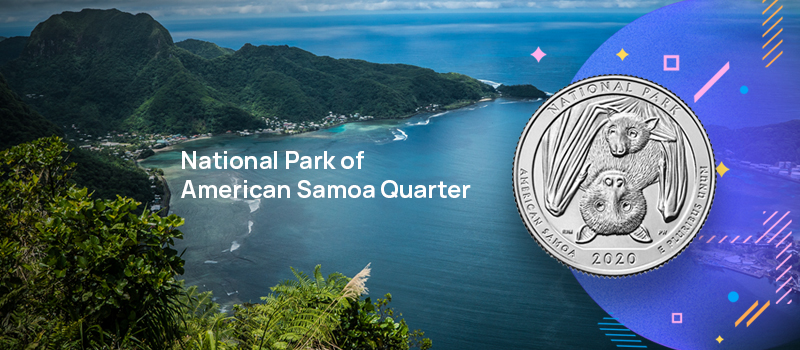National Park of American Samoa quarter

The American Samoa is an unincorporated territory of the United States of America and is in the South Pacific Ocean. The National Park of American Samoa consists of three islands - Tutuila, Ofu, and Ta‘ū. The park was established in 1988 and it preserves 13,500 acres of land and coral reef. The National Park was established to protect the natural habitat of various endangered species of flora and fauna that are endemic or native to the American Samoan rain forest. The 51st ATB quarter honors the National park of American Samoa.
American Samoa
The Samoan islands were settled by the Samoan people some 3500 years ago. Samoa shares historical, genealogical and cultural ties with the Fijian and Tongan island nations that are geographically near it. In the 18th century, Dutchman Jacob Roggeveen was the first European to set eyes on this beautiful island. The French explorer Louis-Antoine de Bougainville visited Samoa some five decades after its first sighting by the Dutch and named it ‘Navigator Islands’. After a few years, in 1787, de La Pérouse, the French explorer and Naval officer landed in Samoa only to be attacked by the locals. The island was aptly named ‘Massacre Island’ by him. Word of the fierce nature of the natives spread among Europeans and most ships gave Samoa a wide berth in their travel itinerary for the next few decades. But by the late 19th century, most sea-faring nations used Samoan islands as a refueling (coal) point.
By late 19th century, most European powers were trying to establish power in the South Pacific islands. After the Tripartite convention of 1899, the Samoan islands were split between the U.S.A. and Germany. This arrangement worked till the First World War. While the German Samoa became New Zealand territory and then independent Samoa; the American Samoa islands, are still an unincorporated territory of the U.S.A. This means that American Samoans are not U.S. citizens but U.S. nationals. U.S. nationals owe allegiance to U.S.A. and are given protection, but they cannot vote in U.S. elections.
American Samoa is home to varied flora and fauna because of its fertile soil and tropical climate. Native wildlife includes flying foxes (fruit bats), Samoan starlings, rare Pacific pigeons and doves, seabirds, skinks and geckos. There are two large types of fruit bats - Samoa flying fox and White-naped flying fox and one smaller variety, Pacific sheath-tailed bat. The islands are covered with tropical rainforest. 30% of plants species are endemic to the islands. The marine life around the islands is diverse and is home to sea turtles, humpback whales, over 950 species of fishes and 250 coral species.
National Park of American Samoa quarter - Design
The reverse design of the 51st ATB quarter depicts a Samoan fruit bat mother hanging in a tree with her pup. The image shows the remarkable care and energy this species puts into its offspring. The design is intended to promote awareness of the species’ threatened status because of habitat loss and commercial hunting. The National Park of American Samoa is the only national park the Samoan fruit bat calls home. Inscriptions are “NATIONAL PARK,” “AMERICAN SAMOA,” “2020,” and “E PLURIBUS UNUM.”
This entry was posted in General on February 28, 2020 by lavanya kannan

Leave a comment